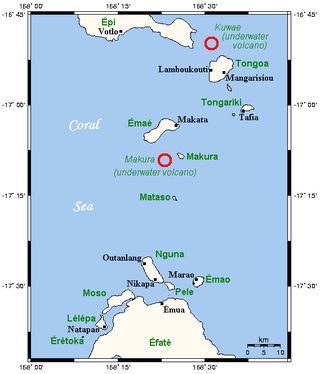In phonetics, rhotic consonants, or "R-like" sounds, are liquid consonants that are traditionally represented orthographically by symbols derived from the Greek letter rho, including ⟨R⟩, ⟨r⟩ in the Latin script and ⟨Р⟩, ⟨p⟩ in the Cyrillic script. They are transcribed in the International Phonetic Alphabet by upper- or lower-case variants of Roman ⟨R⟩, ⟨r⟩: ⟨r⟩, ⟨ɾ⟩, ⟨ɹ⟩, ⟨ɻ⟩, ⟨ʀ⟩, ⟨ʁ⟩, ⟨ɽ⟩, and ⟨ɺ⟩. Transcriptions for vocalic or semivocalic realisations of underlying rhotics include the ⟨ə̯⟩ and ⟨ɐ̯⟩.
Spoken English shows great variation across regions where it is the predominant language. The United Kingdom has a wide variety of accents, and no single "British accent" exists. This article provides an overview of the numerous identifiable variations in pronunciation. Such distinctions usually derive from the phonetic inventory of local dialects, as well as from broader differences in the Standard English of different primary-speaking populations.
Northeast Malakula, or Uripiv-Wala-Rano-Atchin, is a dialect chain spoken on the islands of Uripiv, Wala, Rano, and Atchin and on the mainland opposite to these islands. Uripiv-Wala-Rano-Atchin is spoken today by about 9,000 people. Literacy rate of its speakers in their own language is 10–30%.

The voiced retroflex trill is not a single consonant quality but a sliding cluster sound within the time of a single segment. It has been reported in Toda and confirmed with laboratory measurements. Peter Ladefoged transcribes it with the IPA symbol that is normally associated with the retroflex flap, ⟨ɽ⟩. Although the tongue starts out in a subapical retroflex position, trilling involves the tip of the tongue and causes it to move forward to the alveolar ridge. Thus, the retroflex trill gives a preceding vowel retroflex coloration, like other retroflex consonants, but the vibration itself is not much different from an alveolar trill. Thus, the narrower transcription ⟨ɽr⟩ is also appropriate.
Kuman is a language of Chimbu Province, Papua New Guinea. In 1994, it was estimated that 80,000 people spoke Kuman, 10,000 of them monolinguals; in the 2000 census, 115,000 were reported, with few monolinguals. Ethnologue also reported 70,000 second language speakers in 2021.

The Shepherd Islands are a group of islands lying between the larger islands of Epi and Éfaté, in the Shefa province of Vanuatu. The aggregate land area is 88 square kilometres. They were named by Captain Cook after Anthony Shepherd, a British astronomer and friend of Cook.

Prior to the arrival of Europeans, Australian Aboriginal languages had been purely spoken languages, and had no writing system. On their arrival, Latin script became a standard for transcription of Australian Aboriginal languages, but the details of how the sounds were represented has varied over time and from writer to writer, sometimes resulting in a great many variant spellings of the same word or name.

North Efate, also known as Nakanamanga or Nguna, is an Oceanic language spoken on the northern area of Efate in Vanuatu, as well as on a number of islands off the northern coast – including Nguna, and parts of Tongoa, Emae and Epi.
Zande is the largest of the Zande languages. It is spoken by the Azande, primarily in the northeast of the Democratic Republic of the Congo and western South Sudan, but also in the eastern part of the Central African Republic. It is called Pazande in the Zande language and Kizande in Lingala.
Mota is an Oceanic language spoken by about 750 people on Mota island, in the Banks Islands of Vanuatu. It is the most conservative Torres–Banks language, and the only one to keep its inherited five-vowel system intact while also preserving most final vowels.
Raga is the language of northern Pentecost Island in Vanuatu. Like all Vanuatu languages, Raga belongs to the Oceanic subgroup of the Austronesian languages family. In old sources the language is sometimes referred to by the names of villages in which it is spoken, such as Bwatvenua (Qatvenua), Lamalanga, Vunmarama and Loltong.
Kgalagadi is a Bantu language spoken in Botswana, along the South African border. It is spoken by about 40,000 people. In the language, it is known as Shekgalagari.
Hiw is an Oceanic language spoken on the island of Hiw, in the Torres Islands of Vanuatu. With about 280 speakers, Hiw is considered endangered.
Maba is a Nilo-Saharan language of the Maban branch spoken in Chad and Sudan. It is divided into several dialects, and serves as a local trade language. Maba is closely related to the Masalit language. Most speakers of Maba reside in Chad with 542,000 speakers as of 2019. In 2017 there were 25,000 speakers in Sudan where the language is known as Sulaihab.

Worrorra, also written Worora and other variants, and also known as Western Worrorran, is a moribund Australian Aboriginal language of northern Western Australia. It encompasses a number of dialects, which are spoken by a group of people known as the Worrorra people.
The Lamalama language, also known by the clan name Mbarrumbathama (Austlang) or Mba Rumbathama, formerly known as Lamu-Lamu or Lama-Lama, is a Paman language of Queensland, Australia. Lamalama is one of four languages once spoken by the Lamalama people, the others being Morrobolam (Umbuygamu), Mbariman-Gudinhma, and Umpithamu.
Mengen and Poeng are rather divergent dialects of an Austronesian language of New Britain in Papua New Guinea.
Ot Danum is a Barito language of the central Borneo, Indonesia, spoken by the Ot Danum people. Dialects include Cihie and Dohoi.

Vurës is an Oceanic language spoken in the southern area of Vanua Lava Island, in the Banks Islands of northern Vanuatu, by about 2000 speakers.
Lenakel, or West Tanna, is a dialect chain spoken on the western coast of Tanna Island in Vanuatu.






